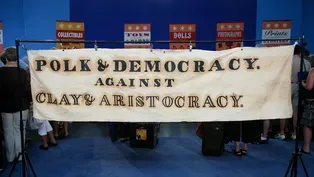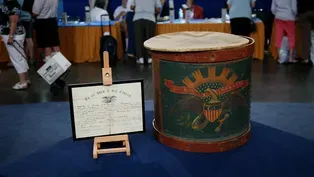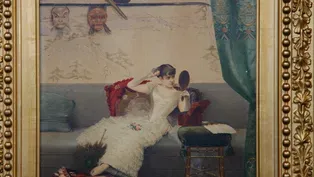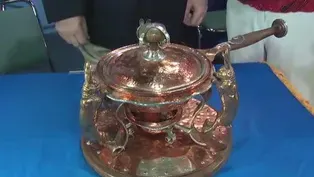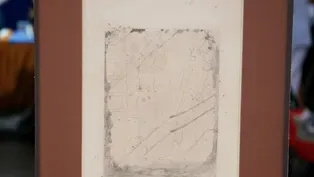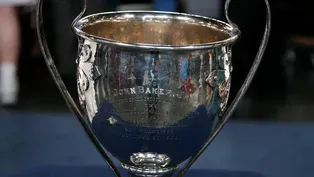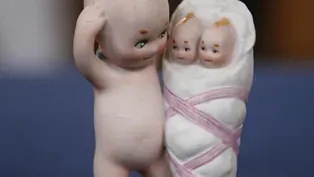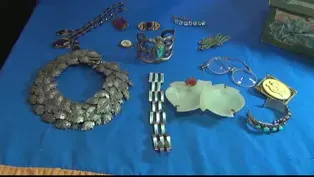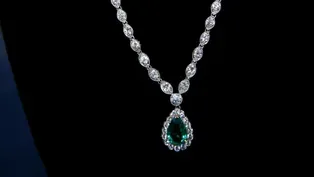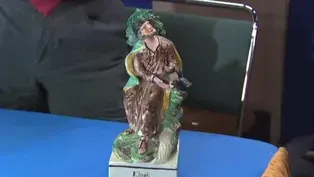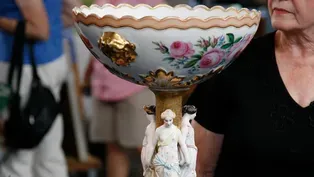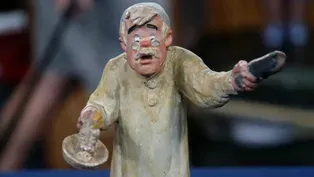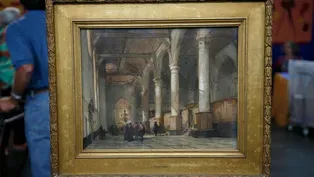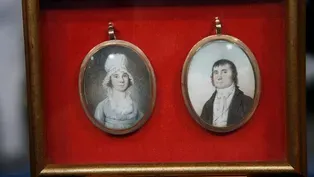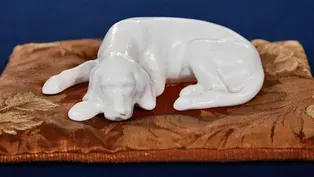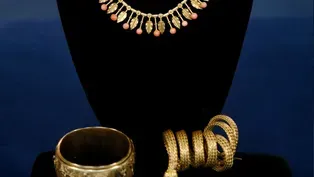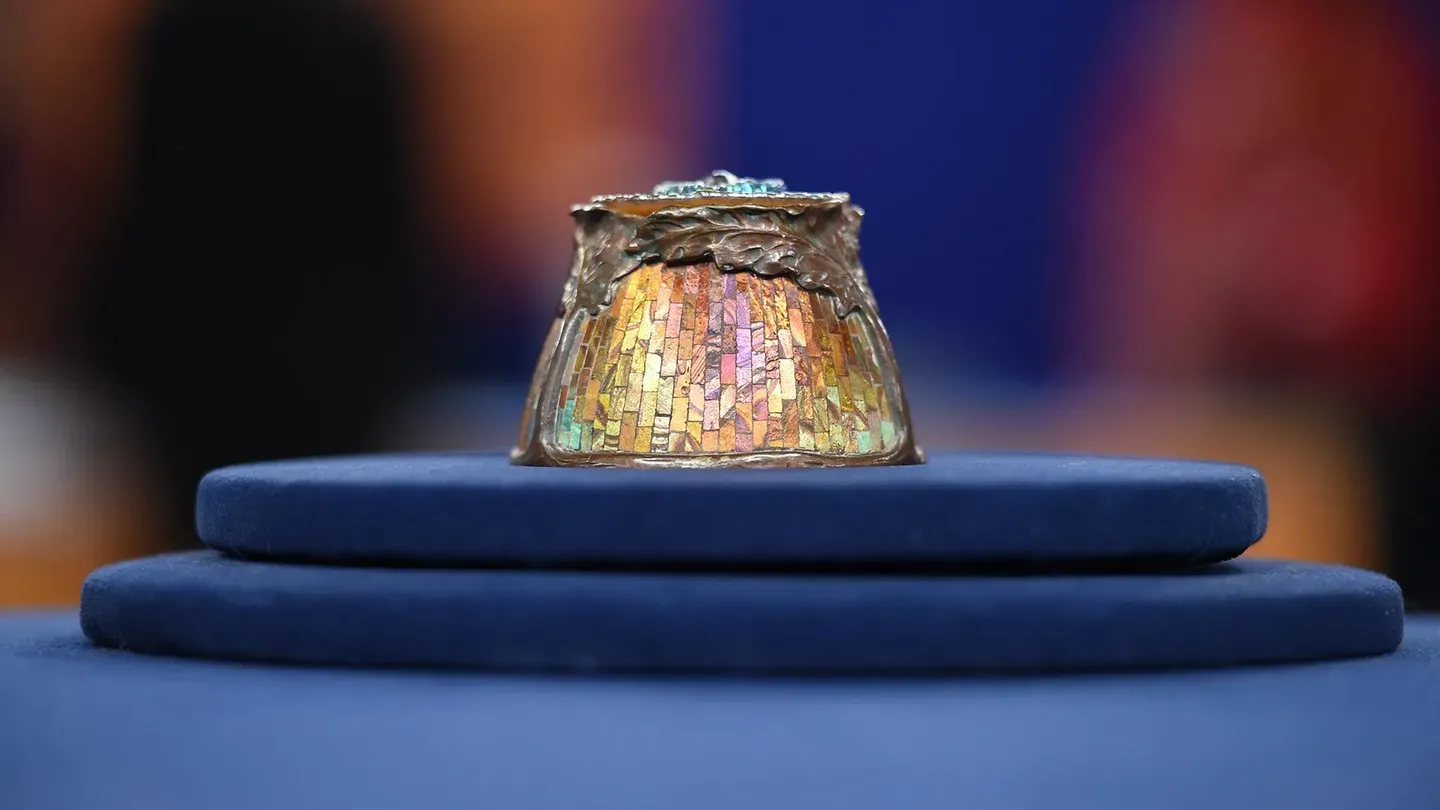

Vintage Orlando, Hour 2
Season 25 Episode 7 | 52m 45sVideo has Closed Captions
Learn how outstanding Orlando items have held up in the market, including a $120K-$180K!
Learn how outstanding Orlando items have held up in the market since 2007, such as a Fern Isabel Coppedge oil, a Tiffany Studios mosaic glass inkwell, and an 1844 Presidential election political banner. Which has a current value of $120,000-$180,000?
Problems with Closed Captions? Closed Captioning Feedback
Problems with Closed Captions? Closed Captioning Feedback
Funding for ANTIQUES ROADSHOW is provided by Ancestry and American Cruise Lines. Additional funding is provided by public television viewers.

Vintage Orlando, Hour 2
Season 25 Episode 7 | 52m 45sVideo has Closed Captions
Learn how outstanding Orlando items have held up in the market since 2007, such as a Fern Isabel Coppedge oil, a Tiffany Studios mosaic glass inkwell, and an 1844 Presidential election political banner. Which has a current value of $120,000-$180,000?
Problems with Closed Captions? Closed Captioning Feedback
How to Watch Antiques Roadshow
Antiques Roadshow is available to stream on pbs.org and the free PBS App, available on iPhone, Apple TV, Android TV, Android smartphones, Amazon Fire TV, Amazon Fire Tablet, Roku, Samsung Smart TV, and Vizio.
Buy Now

ANTIQUES ROADSHOW 2025 Tour!
Enter now for a chance to win free tickets to ANTIQUES ROADSHOW's 2025 Tour! Plus, see which cities we're headed to!Providing Support for PBS.org
Learn Moreabout PBS online sponsorship♪ ♪ MAN: I brought what I believe to be is a Tiffany inkwell that belonged to my aunt, my favorite aunt.
I can say that now 'cause they're all gone.
APPRAISER: There's a very strong family resemblance that has remained throughout.
You look exactly like him.
Okay.
♪ ♪ CORAL PEÑA: Back in 2007, "Antiques Roadshow" saw tens of thousands of collectibles and art in sunny Orlando, Florida.
Hey, Orlando!
"Antiques Roadshow"!
(laughter) PEÑA: No one could have predicted the market ups and downs since that time.
So did these treasures lose, gain, or retain their values?
Find out as we take a fresh look at Orlando.
WOMAN: They were on my husband's side of the family.
And his grandmother had it and gave it to her daughter, and she ultimately gave it to me.
I love her, and I just want to know more about her.
Okay, well, you sure it's a her?
No.
(laughs) Come to think of it.
Well, Kewpies, you really don't know if they're a he or a she.
They're one of those kind of things that could be either/or.
It's a Kewpie.
It was designed by Rose O'Neill, and this particular thing probably didn't come from the old country.
This was made around 1913 up into the 1920s.
So it was probably bought in New York as a little gift for her room.
It's what they call an action Kewpie.
Of course, they're doing things, not just a normal Kewpie standing there.
This is an unusual one with the Kewpie, with the two baby Kewpies.
Very good quality bisque porcelain, maybe made by a company called Hertwig, which was a German company that produced lots of nice little novelty figures.
This particular Kewpie, the Kewpie that collectors call "Down on His Luck."
So I guess he was expecting one baby and ended up with two.
If you look around the back, little blue wings.
All Kewpies that are real Kewpies have blue wings.
No wings, they're not a Kewpie.
Not a Kewpie.
Did you have any idea what you think it could possibly be worth?
Well, I thought maybe $25.
I, I didn't know.
Okay, well, originally, when it was new, it was a little novelty thing made for children.
It probably cost no more than 25 to 50 cents.
It's in good shape.
It's good quality.
And if you can find it, it would probably retail between $4,000 and $5,000.
(laughing): Really?
Yeah, really.
I mean, it's a very rare action Kewpie.
Whoa!
So "Down on His Luck" isn't so down on his luck at all.
Oh, my heavens.
And be very fortunate that you own it.
It's really adorable.
Oh, she will have...
He-- it will have...
It, it.
...will have a place of honor in my home.
Cool.
WOMAN: This is, um, an etching, I guess, or a litho, I'm not sure.
A Picasso.
I bought it in Chicago when I was a art student in 1960.
I used to go up and down Michigan Avenue and look in the galleries.
And I saw this and I thought I could afford it.
I really wanted it, because it is a Picasso and it's a beautiful drawing.
APPRAISER: And how much did you pay for it?
I paid $85 plus tax.
And you, you actually brought in the original receipt from 1960?
Yes.
$85 right there.
You paid in three installments, I see.
Right, exactly.
What you have is an etching by Picasso.
Okay.
And it's one of 15 different etchings that he made in 1904 and 1905.
Oh, wow.
And these are the first prints that Picasso made.
It's a series known as the "Saltimbanques" series.
They're early prints by Picasso, made while he was basically a starving artist in Paris, before he was well-known.
Yes.
Picasso made only a handful of impressions from these plates, and then sold them to a Parisian publisher, an art dealer named Ambroise Vollard.
Uh-huh.
And in the 1920s, Vollard made an edition from these plates.
An edition of 250.
Now, the interesting thing about this is all the dark areas around the edge of the print.
Yes.
That's unusual for a Picasso print or, really, any etching, for that matter, and what it's known as is foul-biting.
Basically, in making an etching, the copper plate or whatever plate is used for the etching is bathed in an acid bath.
Right.
And the acid is only supposed to eat into the lines on the plate where the artist has etched.
Yeah.
In the case of this plate, the acid seeped into the edges and it bit all around the edge of the plate, which gives it this sort of marred look.
Mm-hmm.
For that reason, Vollard, the publisher, destroyed most of this edition.
It didn't look good... Yeah.
...compared to all the other prints in the series.
Right.
Now, the other thing with this print is, over time, it's been light-struck.
I'm going to take it off to show you... ...what happens to a print when it's exposed to light.
The outside, the margins of this print, are what the paper should look like.
Now, all of that can be cleaned up by a paper conservator, and that's something that would cost about $200, $250 to do.
Okay.
Because of the foul-biting, it's more scarce than the other prints in the series.
Yes.
There are only a handful of these in existence, as opposed to the edition of 250 of the others.
Yeah.
So you have a Picasso, and you have scarcity in this Picasso.
Two very good things.
Yeah, sounds good.
The condition hurts its value somewhat.
Yes.
In this condition, at auction, it would sell for roughly $12,000 to $18,000.
Wow.
Now, if you had it cleaned for a couple of hundred dollars... Uh-huh.
...I would expect it to fetch $15,000 to $20,000 at auction.
Wow, wow.
This has been in the family for about 35 years.
China painting was a hobby that the ladies around the turn of the century into the 20th century did at home, like needlework.
And this is really one of the more fabulous pieces that we've seen.
The vase itself is very, very elaborate.
Usually, we just see smaller pieces-- bowls and things like that.
WOMAN: I like to go junking, and I found it one Saturday morning at a yard sale.
The lady was bringing a bunch of stuff out of the house, just boxes and boxes.
And she put it down and I lifted the lid off of it, and I went, "Ooh, how much is this?"
And she said five bucks, so I bought it.
Everything here is good, silver, and mediocre.
Okay.
But as I'm looking through it, I found one piece that I said, "Fantastic."
Yeah?
And I usually don't say, "Wow."
Okay?
That's this one here.
Really?
You didn't even look at it.
No.
Right?
Okay, now, these are all blue stones.
Not too bright, though, so it needs a polishing.
Okay.
And all your stones are aquamarines.
They come out of Brazil.
Really?
Yeah.
This bracelet alone is worth about $1,000.
You're kidding.
(laughing) All right!
There's your answer to your five bucks.
Well, thank you.
Okay.
Can I give you a hug?
Sure.
Yeah?
WOMAN: This is a dog that was on my grandmother's mantel.
I remember it being there all my life.
And my grandmother passed away.
My mother moved into her house and it stayed on the mantel, minus the pillow.
And when my mom passed away, we cleared the house out and that dog just stayed on the mantel.
Nobody took it, so I was cleaning the house, ready for the realtor, and took the little dog.
Looked for the pillow.
I finally found the pillow in my mom's desk.
So I reunited it, and it's been on my mantel.
I don't know anything, other than I know it's by Roseville, because it's got a label.
It has a label, and I'll show you the label right here.
It's underneath, and it's a 1930s label.
It's nice to see this little dog again.
I've met it once before.
Okay.
This is part of Roseville's "Ivory" line.
And we see many different lines of Roseville here at the Roadshow-- usually, 1940s "Floral" lines.
Mm-hmm.
So it's nice to see anything that is done before that.
And it is extremely rare that we see any figurines at all.
A few years back, we held an auction of only Roseville pieces, and one of the very last lots had this dog.
And it brought $1,500.
Hm.
It's pretty stunning, as most of the Roseville items are now in the low hundreds.
Mm-hmm.
And something that is from the '30s that doesn't look like so much would be worth so much and would be such a collectible-- probably because it's a dog, also because it's Roseville.
So it has this cross-action of different types of collectors here.
So I'm so glad you brought it.
Well, thank you.
Should you wish to insure it, you may want to do this in the $1,500 to $2,000 range.
MAN: This is my great-great- great-great-grandparents, Mary Dark and Joseph Ike Manning.
They were from Virginia.
They were born around 1770.
He lived till he was about 46 and she lived till her 60s.
And they've been passed down through my family for generations, and that's about all I know about them.
What I love about these miniatures is that they're 18th-century miniatures, and in my business, we see more 19th-century miniatures.
Yeah.
And they're quite beautiful.
You see her costume and the beautiful dress and the bonnet.
And he, too, with his beautiful tie and stoic expression.
They're really well done and they're very intimate pictures.
And they were probably made as wedding gifts to each other.
Mm-hmm.
What's so nice is that they have remained together.
Often we see splits, and it's, it's very different to see a pair of miniatures.
Another element which I really like about them is that they're from Virginia.
They're wonderful examples and very typical of 18th-century miniatures.
I don't recognize the hand, and if they were to come to auction, I would catalogue them as American School.
Singularly, each miniature would be worth about $2,000 to $3,000, but as they're a pair, I would give them an insurance value of about $9,000.
(chuckles): Wow!
That's great.
They're really lovely, and I think that they're obviously a key to a good marriage.
They've stayed together for near... For more than 200 years like that.
Okay.
Now, one thing that strikes me; if you wouldn't mind taking off your glasses.
'Cause you look so similar.
I mean, there's a very strong family resemblance that has remained throughout.
You look exactly like him.
Okay.
WOMAN: My father would collect antiques on the Lower East Side, probably in the 1930s, 1940s.
He, um, was a butcher by trade, and that was the family business.
And he never liked it.
He always liked fine art, and he collected European bronzes and jewelry whenever he saw it.
And he never spent more than $50.
$50?
Probably would be the tops that he ever spent, even if that much, because he didn't have the money, so... And this was back in the Depression and after that.
Yes, after that.
And I assume the jewelry he bought for your mother?
Yes.
Well, he had quite an eye for antique jewelry.
The necklace is what we call Etruscan Revival.
And this is a copy of an ancient necklace made probably in England or in Italy about 1870.
It has coral from the Mediterranean-- very beautiful, almost angel skin coral-- and 18-karat gold.
The second piece that you brought is this wonderful serpent bracelet that's kind of curlicued.
He has little diamond eyes, and these are woven out of 18-karat gold mesh.
And it has a steel core that runs through it.
You could wrap it around your wrist and wear it as a wrist bracelet, or even up on your forearm.
And then the third is a solid-gold bangle bracelet with a series of figures on it.
The motif on the bangle is Assyrian Revival, and there are these winged figures with a lion's body.
Both of the bracelets are Victorian, and I would think of European manufacture.
These aren't the kinds of things that were made in the United States at this time.
To give you an idea of how good an eye your father had, this Victorian Etruscan Revival necklace would bring about $15,000.
Oh, my.
And these serpent bracelets sell in good antique shops for approximately $7,500.
(chuckling) Now, the Assyrian Revival bangle is also a $15,000 piece of gold antique jewelry.
So, your father, who would never pay more than $50 for a piece of jewelry, left you quite a nice collection.
Wow, thank you.
This rug was a gift to my husband from his grandmother, and she used to volunteer with the Indians in New Mexico-- the Navajo Indians.
This thing's got six swastikas on it.
This was woven before World War II, and that was an Indian symbol.
Not only an American Indian symbol, an Indian symbol in India.
Ah.
It goes back thousands of years.
And it's nothing to do with Nazis.
It's a religious symbol in a number of countries.
But the Nazi regime spoiled it, and it's affected the value of these weavings.
I yard-sale with my friend a lot, and we were out one Saturday, and it was sitting on a table with a bunch of broken stuff, and I was just drawn to the cats and dogs on it and the way it looked and everything, and I liked it.
And mice.
And mice, and I went back three times and looked at it, and finally, I said, "I have to have it," so I bought it.
And you paid how much for it?
Two dollars.
Two dollars.
How long ago did you buy this?
About a year and a half to two years, and I've had it in a cabinet since.
So, what have you found out about it since you've had this?
Nothing, except that it says "Rookwood" on the bottom.
Okay, well, it does say "Rookwood" on the bottom.
Mm-hmm.
Right over here.
Okay.
And it also says "Cranch," and that's for Edward P. Cranch, who was an early-period Rookwood decorator.
Oh!
And his work is typified by this incised, sort of illustrative style.
Oh, okay.
And he was kind of an odd guy.
Uh-huh.
And used a very peculiar subject matter.
Here we have cats reading books, and...
I thought it was very peculiar, yeah.
Yeah.
This incised, or sgraffito, decoration with black outlining, almost always on this sort of brown background, is what he's known for.
Oh, okay.
He tended to repeat scenes.
He only worked for a couple of years, so it's quite rare.
Oh, okay.
Usually from about 1880 to 1884.
That's great.
But this one I've never seen before.
And I also like the fact that it's got its original stopper.
If this is all it had without the chain, I would have assumed that the stopper was lost.
Okay.
And somebody just put a cork in it.
But this is, is the original stopper.
Oh, that's great.
So I'd say a couple, three years ago, this piece might have been worth about $500 to $700.
Mm-hmm.
Today, without this decoration, but with more typical decoration, about $1,000.
But because of the cats and the dogs, I'm thinking maybe between $1,500 and $2,000 retail at auction.
Oh, that's wonderful.
Oh, that's wonderful.
Okay?
Very good, so that was a good investment on my two dollars.
I'd say that was a good yard sale find.
That's right, that's right, that's right.
MAN: Well, I have here a political banner that's been handed down through my family.
My father's grandmother, my great-grandmother, gave it to him.
Her name was Sophronia Lincoln Angell, and her parents were from the Lincoln family, and she collected political memorabilia.
Each generation has had a caretaker for it.
It's my turn now.
The Lincoln family originally split, and one branch of the Lincoln family produced a gentleman by the name of Abraham, and the other...
I've heard of him.
Yes.
And the other branch of the family produced me.
Okay.
So... Well, this is a piece of campaign memorabilia, campaign ephemera, from the 1844 presidential election of James K. Polk versus Henry Clay.
And this was a really fairly tumultuous election.
Henry Clay was the candidate for the Whig Party, and this was his third run at the presidency.
This was sort of his last chance, now or never.
The Whig Party is the ancestor of what we today think of as the Republican Party.
Right.
Your cousin, Abraham Lincoln, was a party man for the Whigs in Illinois around the time of this election.
And Polk was the candidate for the Democratic Party.
Right.
Which we today call the Jacksonian Democratic Party.
It was the party of Andrew Jackson, and he was very much a candidate in the same mold as Andrew Jackson, really, same platform.
The big issues for the 1844 campaign were, first, slavery, and second, Manifest Destiny.
Right.
Polk and the Jacksonian Democrats were in favor of annexing both the Oregon Territory and Texas, and Clay was very much anti-slavery, and in particular, anti-annexation.
What's interesting about this banner is that it tells us an awful lot about that election.
"Polk & Democracy against Clay & Aristocracy" is leftover Andrew Jackson sloganeering.
Andrew Jackson was the first really populist president.
He was the one who sort of came up with the idea of the common man versus, uh, these elitist, moneyed snobs.
So you can see, even though Polk doesn't have a lot of cachet himself, he's using Andrew Jackson's political rhetoric to get elected.
What also I like about this piece is that your...
Your great-grandmother, you said?
Your grandmother?
Great-great-grandmother.
Your great-great-grandmother made it.
So here's a woman who doesn't have the vote, right?
But is still incredibly involved in politics...
Right.
...is a Democrat, whereas your other distant cousin, Abraham Lincoln, would have been part of the Whig Party.
So there might have been some fighting...
Right.
...at, at family reunions.
So it's a great political piece of memorabilia.
It's also a great piece of Americana.
It's on simple cotton muslin.
We have these original iron handles, and then your ancestor has stamped her name.
She's actually put her signature on this.
The piece is hand-lettered.
You can actually see the pencil, and the letters are in oil-based paint.
It's a really terrific piece.
I would put this at auction between $5,000 and $7,000.
Oh, great.
Great.
So thanks for bringing it in.
It's really great.
My pleasure.
MAN: I brought what I believe to be is a Tiffany inkwell that belonged to my aunt, my favorite aunt.
I can say that now 'cause they're all gone.
And I don't know much about it other than it does say "Tiffany" on the bottom, and it's been a favorite piece of mine she had since I was a child, and I, when she passed away, I asked for it, and they let me have it.
I'm very familiar with this.
It's a very lovely inkwell made by Tiffany, and what's interesting about it and what makes it rare is that it's a mosaic inkwell.
The production was more limited than on the other inkwells that were made, that were usually parts of larger desk sets.
Mm-hmm.
I've seen, probably, over the years, about four or five of them.
And every one of them is different, because the work that you see, all of this beautiful inset glass tile, which was made by Tiffany, also, is inset slightly different.
I've seen them with Cypriot glass tile.
I've seen them with the tile that looks a little more like this.
But one of the things that I've always noticed is that the color gradates.
So it's usually a little brighter at the top, and then it gets darker as it approaches the bottom.
I've never noticed that.
This does have some condition issues, where you're missing two tiles.
That is a bit of a problem, although it can be restored or conserved.
But it needs to be restored with the tiles that are going to match the others.
And it has to be done by a professional conservator who knows how to make the tiles actually adhere.
It's not just a question of sticking glue on and sticking them in.
It doesn't work that way.
And that will affect the value in some way.
Some collectors would just buy it in the condition it's in and say, "I don't want anything done to it."
But others would prefer to have it look as though it were brand-new.
Mm-hmm.
Now, there's one other condition issue, which is the top of the inkwell, which seems to have been pushed down.
Did this something happen in your house?
Not as long as I had it.
It was that way since I was a child and my aunt had it.
It's always had that condition.
Okay.
Well, as I lift it out, I'm going to show you.
I'm going to turn it on its side.
Now, also in addition to the bronze liner, you also have a glass liner, and this looks like there was ink used in it a long time ago, and it's still there.
And it's not really important whether you clean it out or not.
Now, you showed me a signature on the underside of the piece, but there's also a signature here.
Not only does it say "Tiffany Studios, New York," but it also has a monogram for Tiffany Glass and Decorating Company, which was the earlier company that Tiffany established in the 1890s, where a lot of the mosaic work was actually done.
Oh, okay.
Most of these inkwells that I've seen are marked that way.
So we know they're early.
We know they're circa 1900.
In its present condition, whether it's in a retail venue or in an auction venue, it's worth $15,000.
Whoa.
(chuckles) If you were to have it conserved-- it probably could cost close to $1,000 just to do all the work-- then it probably could be worth easily $20,000.
Wow.
Now, if it were absolutely perfect, it would go for anywhere between $25,000 to $30,000.
Goodness.
Wow.
So... That's a lot of ink.
That's a lot... (chuckling): Right.
Exactly.
And it's a beautiful piece, and I was really excited to see it, because they are really quite rare.
Thank you very much.
You're very welcome.
WOMAN: I brought this Civil War drum.
It's from my great-grandfather, from the Rhode Island area, and a certificate that shows that he was actually the drummer in the Civil War.
Right.
And, if you notice, it mentions that he is a drummer of Company L in the Ninth Regiment of Rhode Island Infantry.
And it's an interesting regiment that he was in.
The Ninth was raised because they were afraid that Washington, DC, would be occupied by the Confederacy.
In May of 1862, General Stonewall Jackson had had decisive battle victories at Winchester and in the Shenandoah Valley.
The next step, they were right at Washington, DC.
And so President Lincoln says, "We've got to have regiments to defend the city."
He sends a letter to the governor of Rhode Island, and they call up the Ninth Infantry.
They're sent there to guard Washington, DC.
And if you notice, the drum also has the matching Ninth Regiment, "R.I.," for Rhode Island, Infantry, and Company L. It has everything on it that you would expect.
They were only in service for three months, which is why the drum is in such beautiful condition as far as the paint.
It has bright colors.
It's a beautiful drum.
The heads do come off.
It's in need of some restoration.
Right.
If you notice, right here, we have the maker's label, from Horstmann of Philadelphia.
Mm-hmm.
One of the premier makers during the Civil War.
They made things, and they also retailed items for military use.
We have both of the original heads.
All we're missing is, basically, the tension ropes.
We have the snare on the bottom.
The discharge... Has it been in the family the whole time?
Yeah, actually, I was going through a trunk, finding things to maybe bring, and I found this only, like, a week ago.
Really?
Wow.
And connected it to the drum.
That's great, because it mentions in there that he is a drummer boy.
Right.
In the discharge.
The discharges you do encounter, because every Union soldier that survived would have gotten one, and that was their ticket, in later years, to be able to draw a pension.
Right.
A lot of drums were surplus, meaning they never saw service.
Mm-hmm.
And they'll actually come out, and you won't have the regiment, you won't have the state, and you won't have the company.
They would paint the basic drum, and then, once it made it into the field, the drummer boy himself, or somebody in the regiment, would add that information on it.
Which personalizes the drum.
Uh-huh.
So it's, not only do we have his discharge, we've got his input on the drum.
And it brings everything together.
Yeah.
It's, it's a fantastic piece.
Well, I can tell by that look in your eye it's something you'd never part with.
Oh...
So what we'd be looking for is an insurance appraisal.
Right, right.
And, on a discharge, most of the time they're $100 to $200.
The drum itself would need to be insured for $7,500.
Wow.
Wow.
WOMAN: This was awarded to my great-grandfather in 1908 for a sales and marketing event that happened with Union Oil.
And that's pretty much all I know about it.
APPRAISER: It was presented in 1908, which, in San Francisco, there was the earthquake and the terrible fire of 1906.
Right.
So this is not very long after the devastation that happened in San Francisco.
And this is a piece made by a San Francisco silversmith, Shreve and Company, of San Francisco.
Okay.
Which is a firm that had East Coast connections and then moved to California.
Benjamin Shreve stayed on the East Coast, and he later became involved in the Shreve, Crump, & Low company that's in Boston, that's, that's also a famous company.
But this piece just shrieks Shreve and Company, San Francisco.
They made all kinds of silver.
They made plainer neoclassical silver, but this was sort of their stock-in-trade, this type of medieval-style Gothic Revival.
Beautiful hand-hammering, and this is classic Gothic-Revival strap work that you see here.
And these really sort of sexy loop handles that, that make it sort of masculine and feminine at the same time.
It's just a gorgeous, eye-catching piece.
In terms of auction value, I think that it would be about $4,000 to $6,000, so... My, my!
(laughs) Thank you.
That's awesome.
Well, thank you.
I'm very excited.
I bought them in an antique shop in Poconos, Pennsylvania, about 21 years ago.
Mm-hmm.
And I just kind of fell in love with them when I saw them.
That's really all I know about them.
One nice thing about these vases is, both of them are hand-painted on the back.
Uh-huh.
So you could actually turn them different ways if you had them on your mantel.
I've heard of stories of people having vases with two sides, and the summer, they would show one side, and the other side, winter, they would show another.
Uh-huh.
And the backs are so beautiful, that if you turn them that way, you wouldn't necessarily know that it was the back.
Right, that it's the other side.
What's interesting about these vases is, we cannot determine who made them.
Oh, okay.
But it kind of doesn't really matter as far as the monetary value.
WOMAN: My Aunt Eva was a secretary for a gentleman from 1915 till about 1929, with the crash, and she was getting married, so he had gone over, acquired two pieces in China as a wedding present.
So this was made in about 1760 to 1780.
It's a washbasin.
No decoration... on here.
It was made to set into a wood stand.
Ah!
Sort of a table stand.
And there was a ewer to pour the water from.
Okay.
So you'd wash up.
Yeah, I go to the flea market almost every week and I collect antique stuff like this.
How much did you pay at the flea market for it?
Ten dollars.
Ten dollars, yeah.
You've really got a good item.
It's a great piece of English pottery modeling, made, I'd say around 200 years ago, maybe 1800, 1810.
Depicts the Prophet Elijah and the raven.
And it's got some condition problems, got a few little chips here and there.
The raven's wing is missing, and there's some repairs through it, which is pretty common for something this age.
But generally, it's in good shape, and these things can be fixed.
Now, in this condition, it's gonna be, I would say, over $600 and maybe as much as $1,000.
It just, it's a great figure.
If it was perfect, you're looking at over $2,000 and maybe $3,000.
Mm-hmm.
MAN: As I understand it from my mother, it was made by my great-grandmother.
And they lived in Indiana.
It must be somewhere around 100 years old.
That's all I know about it.
I have never seen a more wonderful patchwork quilt.
The condition is incredible.
The unusual thing here is that it's done on a wool background, and very few of them were.
All of the needlework is done in wool, also, so it's really an embroidered quilt.
The more I looked at it, there were just a dozen more things that I wanted to point out.
Tell me what your two favorite things are in the quilt.
Oh, gosh, that's so hard to say.
Um, it looks like there's, like, an ibis, almost an Egyptian ibis there, with that kind of coloration.
There's a platypus over here, I mean, these are things that...
I have no idea how my great-grandmother would have gotten the images so good.
Because I'm sure she never actually saw them, real life.
She must have had a book on animals to have done it.
Yeah, absolutely.
Well, my favorite is Noah and the Ark up here.
And she must have been religious, because we've got the Bible here.
There are just so many different things here.
The knife, fork, and spoon, and the scissors.
I've just never seen more wonderful objects so beautifully stitched.
Now, what do you do to preserve this?
We store it in a cedar-lined chest, and we just fold it loosely in there.
We just try to keep it out of the light and away from moths and air conditioning.
You know, so...
Okay, well, moths are the most important thing to keep it away from.
And you should, four times a year, take it out and refold it so you don't get fold creases.
And now, have you ever had it appraised?
No, we've never... Do you have insurance on it?
No, I have no idea on value.
Well, Mike, I want you to go home and insure it for $10,000.
Wow.
MAN: It hung actually in my father's house in New York City, and he had it for many years.
A couple of years ago, I took it out and started to do some research with it.
And then I just put it back under the bed, actually, and covered it up really good with a heavy blanket.
So, uh, what'd you find out about this?
Well, I believe the artist is from Belgium.
Georges Croegaert, born in 1848.
He is Belgian and he lived to about, I think, about 1923.
He was known for doing these young ladies and interiors.
And, and boudoirs like this.
But he's more known for doing cardinals, um... Wow.
In, in red dresses, in, in libraries, sipping tea, having a glass of wine.
But what's consistent in the boudoir paintings and the cardinals is his intense attention to detail.
It looks that way, yeah.
And you... And you see that here in this painting.
Yeah.
He revels in it, he almost uses one-hair brushes to be able to do the kind of detail you see in here.
Wow.
This is actually a fairly large painting for him.
What's interesting about this, though, this painting was done in the 1880s, and it also brings something else to light, and that is the interest in the Asian arts.
These are things that would be around an artist's studio in the 1880s-- there's an intense interest in particularly Japanese things, and most of these objects that you see up here are Japanese.
The painting in the background, as well, is Japanese-inspired.
And then you go on down.
You find this beautiful young lady here looking in the mirror.
Yes.
Um, getting ready for an evening out.
Do you know what she, she might be doing?
Well, my father's wife explained to me one time that possibly it could be a prostitute that was lounging for her next client.
Yeah, I think we might more politely call her a courtesan these days.
Excuse me.
And as you go down, you see these beautiful details, the roses behind her ear and down on her lap there.
You have this peacock fan.
The artist loves to put all these details in.
It's beautiful.
Then you have a beautiful Persian carpet down here.
Everything is, is to the nth degree.
Then finally, down here, you see his, his name, and it's Georges Croegaert-- very finely done, it's hard to read-- and then below there, Paris 1886.
When you're down here, you also see a little condition issue.
Right.
Not only is the painting is a little bit yellow, but here you have what's known as frame rubbing, down in this corner here and then down in front.
Because it's on a panel-- this is on a mahogany panel-- they tend to be very stiff and they rub right up against the frame, so that can be cleaned up a little bit by a professional restorer.
It's also interesting, the name's wrong here on the nameplate.
There aren't as many of these as there are cardinal paintings, and cardinals today aren't as popular as they were 100 years ago.
People just don't buy religious paintings as much.
But even still, during the time, the ones with pretty young ladies would be more popular.
If this were a cardinal painting, I would probably say it's about $8,000 to $12,000.
Because you have this woman in a boudoir, I'd put an estimate of $30,000 to $50,000 on this painting.
You're kidding.
Yeah, yeah, and it could do better.
Wow.
Yeah, it's, it's a great object.
It's a beautiful thing, it's at the top of his game.
Wow, thank you.
MAN: My mother bought this at a friend's garage sale in 1968.
We were doing a little remodeling on the old farmhouse, she wanted a new dining room light, so we've had it since '68.
I inherited it, and we had it at our house in Michigan before coming to Florida, and we've been trying to get one of our kids to take it to their house.
They just all moved into homes.
(laughs): So maybe after today, one of them will take it.
Have you had it appraised it all, or...?
Not really.
We had a good friend, colleague, that, when my mom died, took a look at it, and she said, she says, "I believe this is a Tiffany."
She said, "Be careful with it."
She said it could be worth a couple of thousand dollars.
That was a few years ago-- we just don't know.
Well, it is stamped here with a factory stamp.
Tiffany Studios, New York.
However, there are a fairly good-sized number of very high-quality reproduction shades.
Okay, okay.
So my colleagues and I at the glass table went over this very carefully.
Of course, Tiffany was known for the quality of the glass, the quality of the leading, and the quality of the whole package.
Okay.
And we would be very comfortable saying it's a Tiffany shade.
Oh, okay it is.
This shade was made in the early part of the 20th century, and the pattern for this is "curtain border."
It's known as one of the geometrics.
Okay.
Now, apparently, your wife had cleaned some of... We had that, that mortal mistake that... Again, before you know what you have, and, you know, that's a good thing for everybody to learn from when they're watching "Roadshow," you know, that it's there.
That was one of the things that threw us for a little bit, because this bronze cap seemed a little new.
Yeah.
Because of the cleaning.
Well, you, you stopped before getting too, too bad on it.
That doesn't affect the value too much.
There are some minor cracks and lines throughout the shade that, again, they don't affect the value too much.
Could you tell me how much your mother paid for it?
It was 1968, it was $75.
$75, okay.
I think a good auction estimate for this would be $10,000 to $15,000.
(chuckles): Wow.
I know very little about it.
I bought it in 1993, and I've tried to research it, not... Been hitting dead-end streets.
What I think it is is Hispano-Moresque in style, copying what was done in Spain in the 15th century.
It is not anything that should be considered as a fake.
It's simply a later manufacturing, with the style changing over time.
WOMAN: Well, it was handed down to me by my great-grandfather, and I've just always been curious as to whether or not it was an original piece or whether it was mass-produced at the time.
The date says 1904, so it's obviously very old, and, um, just want to know more about it.
Okay, well, it actually is from 1904, and it's something that I've seen before a number of times.
Uh-huh.
It's a chafing dish on stand, but it's copper with silver on it, also.
And then these wonderful little bunnies... Yeah.
...are cast out of bronze.
All of this is hand-hammering.
Yeah.
Really wonderful, wonderful craftsmanship.
Did you get it this way?
Was it this shiny?
Um, yeah, it was.
Mm-hmm, it was.
Yeah.
Well, that's one of the problems with the piece.
Okay.
Because it's not supposed to be shiny like this.
Oh, all right.
It's actually supposed to have a very dark, brown patina on it.
Ah... And then the silver would have been polished to contrast against the dark, patinated copper background.
Right.
And this is one of the instances where polishing it, or it being in this condition, really decreases the value tremendously.
I see.
The way it is now, it's still worth probably about $600 or $800.
Okay.
If it was with the original patina on it, it would probably be in the $2,000 to $3,000 range.
I see.
Is it possible to remove the patina and put it back in its original form?
Well, the patina's already been removed.
So what you're seeing, this is the raw copper.
Oh, I see.
So it's shiny, like a new penny.
Yeah, right.
You can have a restorer put a patina on it.
You know, in terms of the market, you'd have to tell the person that that's been done.
It probably would increase the value.
Yeah, yeah.
Because it would look more authentic.
WOMAN: Well, as far as I know, it was given to my great-grandmother by my great-grandfather in Washington, DC.
Subsequently, when she died in 1968, it passed to my grandfather, and he obviously gave it to my grandmother, and when she died in 2001, it was given to me.
Well, it's a lovely gift to have received.
Yes, it is.
The necklace itself dates from about 1900 to about 1910.
So it's the era we call the Edwardian era.
And what the jeweler has very beautifully done here is that, from a distance, these look like they're marquise-shaped stones.
But when one looks very close at the way the settings are created, they're actually round stones set into these individually hand-built marquise mountings, so as to give this beautiful streamlining effect to the collar, to the neckline of the necklace.
The other part of the necklace that I find very interesting is the fact that, with this beautiful emerald here at the base, the jeweler very consciously made it so that the pendant is detachable, so that other items could have been used, as well.
And if we take a close look, the pendant will detach, and you could then fold up the little clasp.
And just wear that as a chevron-shaped necklace, as well.
And so in inspecting the item, I was very much taken by not only the level of craftsmanship, but the degree of craftsmanship.
And oddly enough, there's no signature on the piece.
Typically, with an item of this quality, one would expect that there would be a signature on the item, but in this case, there is no signature.
The necklace has about six-and-a-half carats worth of diamonds.
The emerald at the base here, the pear-shaped emerald, weighs just a little over two carats.
The stone itself is a very fine-quality stone.
It's very green, it's very clear, which is ideal in an emerald.
I noticed these gold prongs-- were these replaced?
No.
There is an age-old tradition where diamonds are set in platinum or white metal, and colored stones are set in yellow.
So you typically will always see this, where an emerald, a ruby, or a sapphire from this period, the mounting may be in platinum, but the surrounding mounting to hold the stones will be in yellow metal.
Platinum's a very hard metal to use.
And because emeralds are sort of soft, you want to make sure that you weren't putting too much pressure on the stone while it was in the setting process.
(softly): Okay.
In terms of what we would call fair-market value or auction value, one could expect to get anywhere between $15,000 and $20,000 for the piece at auction.
In terms of insurance, the item should probably have an insurance value of somewhere around $35,000 to $45,000.
Okay.
Wow.
So it makes a nice gift.
Yes, it does.
MAN: As far I know, it's a model of Geppetto from "Pinocchio," and I think it was produced at the studio approximately contemporary with the making of the film.
I picked it up at an estate sale up in Winter Park, which is just north of Orlando.
Uh, got a pretty fair price on it, I think.
But I'd like to find out a little more about what it is exactly.
When you got it, what did you pay for it?
I paid $200 for it.
It was what I could take out of the ATM the time, after running to it and telling him to put it on hold, and came back, and it was still there, and came away with a Geppetto.
Okay, great, well, obviously, it is Geppetto.
In 1940, Disney Studios produced a full-length cartoon, "Pinocchio."
It was done after the book by Carlo Collodi, and this is an animator's model from that particular movie.
At the time, Disney Studios had the best of the best in animators.
You had Frank Thomas, Ward Kimball, Fred Moore, Art Babbitt, who was credited with doing the animation of Geppetto for that movie.
These are quite rare, unusual to find, especially at a estate sale like that.
When you look at the piece, you're really getting a feel for the way the artists wanted the character to look.
And that's what the artists would do.
They would use these to remind them of what they wanted to draw, how they wanted it to look.
And if you look carefully here, you can see, sticking between his feet, is Figaro, his cat.
Just a, it's just really a wonderful, wonderful piece.
Condition is nice.
Does have a little chipping, a little flaking.
But remember, these were made out of plaster, so it's amazing that it even survived.
Just to have the candlewick there with the flame still intact, it's amazing.
A lot of people say, "Gee it's got chipping.
"It's got flaking, it's got some cracking.
"Should I restore it?
Should I invest money and fix it up?"
I'm a real firm believer in keeping things even in rough condition, but original, rather than restoring it and making it look new.
Also, along the bottom edge, you'll notice it's marked W.D.P., which stands for Walt Disney Productions.
So that verifies also the age of the piece, Walt Disney Productions being after the Walt Disney Enterprises.
It's a remarkable piece of animation history.
As far as value goes on it, I would put an estimate somewhere between $6,000 and $9,000.
(laughs): Wow.
For auction purposes.
Yeah, I mean, you just don't see them.
Vintage Disney collectors love this kind of stuff.
It's a great buy, certainly... That's...
Certainly well worth the run to the ATM that you made, for sure.
That's amazing.
Absolutely amazing.
I actually moved here from Philadelphia, where I grew up, and this painting came into my family through my grandparents.
My grandfather was a surgeon in Philadelphia, and one of his patients was named Fern Coppedge, and I believe that this painting was something that Fern gave my grandfather in, in gratitude for the surgery that he performed on her.
Uh, then my parents had it for some time, and then it came to me, so here we are.
Hm.
You know, I have a theory that doctors actually have the best art collections, because so many impoverished artists end up paying their bills with paintings.
(chuckles) Do you know much about Fern Coppedge?
Have you... Not a lot.
We have another Fern Coppedge that my sister has.
Mm-hmm.
It's much smaller.
The only thing that I know about this painting, that my parents told me, was that it was a scene in Conshohocken, Pennsylvania, near where I grew up, and that it was called "Goat Hill."
Well, Fern Coppedge is, she was originally from Illinois and then studied in Chicago, and then moved to Philadelphia, where she had a, a studio.
She is best-known, though, for her work done around New Hope, where she moved in 1920.
And she's associated with a group of artists known as the Pennsylvania Impressionists.
And of that group, she's probably the best-known of the, the woman artists.
She studied with Daniel Garber, who was probably the best-known of them, along with Edward Redfield.
She was an en plein air painter, by that I mean she worked outside, out of doors.
She wasn't studio-bound.
Mm-hmm.
And she could be seen in New Hope and the area in the back of her car with her easel, sitting, doing these wonderful winter landscapes.
That whole market is, is very much in demand, and has been for some time.
Really?
She was very much someone who plowed her own furrow.
She was her own woman, and I really admire her for that.
Her sense of color was just extraordinary.
She was basically a Fauve painter, and very adventurous in the way that she chose to, to work and to portray the area.
Quite variable in terms of her output, and I think this is an absolute gem.
The other thing that's interesting about it are the dimensions.
It's actually 30 by 36, which is unusual for her.
Really?
She often did 18 by 18, or she did 20 by 24.
The largest I've seen is 38 by 40.
And sometimes she'd work as small as 12 by 12.
I've never actually handled a 30-by-36 painting.
I have to ask you about the frame.
This doesn't quite go with the painting, in my view.
No, I replaced the frame years ago.
The frame that was on it had pieces that were glued on, and many of them had broken off, and so I didn't think it was suitable to keep a damaged frame with it.
Now, I don't know if that affected the value in any way, but... Well, it may well have originally had a frame by either Harer or Badura, who were the two leading frame makers in that area, and she often used those for, for her works.
It's maybe not the frame I would have chosen, but it, it looks after the painting and it presents it well.
The other thing I wanted to mention is the composition itself.
It really does lead your eye in here, with the road, and then over this bridge, and then up the hill going up here, and I've, I've seen her using this device before.
It's very charming, it's just a wonderful compositional way of, of pulling the viewer into the painting.
Now, I've handled a lot of work by this artist, and as I mentioned earlier, I think this is a particularly good example.
At auction, I'd feel very comfortable with an estimate of $120,000 to $180,000.
(gasps) And, actually... (stunned): How much?
What'd you... $120,000 to $180,000.
Oh, my goodness!
(laughs) And I could actually easily see it making over $200,000.
Oh!
You're taking my breath away.
You seem surprised.
(laughing): I'm stunned.
I am totally stunned.
(stammering): I...
I didn't even think about bringing this-- this was a last-minute, "Oh, well, why don't we take this one, too?"
You chose well.
It's... Oh, thank you so much.
Not at all.
Thank you so much!
PEÑA: You're watching "Antiques Roadshow: Vintage Orlando."
Get "Roadshow" day or night.
Follow @RoadshowPBS and watch us anytime at pbs.org/antiques and on the PBS Video app.
Coming up, it's the Feedback Booth right after this.
PEÑA: And now it's time for the Roadshow Feedback Booth.
I came in with a million-dollar smile and I'm leaving with a five-dollar smile.
That's right.
My fake Newcomb Pottery was not worth anything, but my Steiff Owly Owl from the 1940s was worth $40.
We came to the Roadshow, and I brought this piece hoping it was a Tiffany.
But it's only a piece of carnival glass.
And what we learned today was that I don't have as good of an eye for art that my wife does.
(laughs) Mine's a reproduction.
But my wife, however...
This is from the 1920s, it was made in Germany, and we were told it was valued at a little over $100.
And we paid a quarter for it at a yard sale, so we're having a great time.
We're having a ball-- thank you!
I brought this hand-painted egg that I thought was gonna be a good deal, but it probably tasted better than it's worth.
We brought this oil painting, which we found out is perfect for hanging back in the guest restroom when we get back to Lakeland.
And I made my husband cut our vacation short to bring me here to "Antiques Roadshow."
And I'm glad I came.
And I found out that our baseball cards that my dad saved from 1963 is enough to pay for parking.
But... (laughs) We still, we're still glad we came here and wouldn't trade it for the world.
And we brought our doll in today, and we found out she's really only worth about $50, but her outfit is worth about $300.
(laughs) We found this watch in my mother-in-law's safety deposit box after she died, and we should have left it there.
Not only is it ugly, it's not worth very much.
(strumming): ♪ We came to the Roadshow and brought our stuff ♪ ♪ But it wasn't quite good enough ♪ ♪ We had a good time and we're glad we're here ♪ BOTH: ♪ Guess it's time to go get a beer ♪ PEÑA: Thanks for watching.
See you next time on "Antiques Roadshow."
Appraisal: 1844 Presidential Election Political Banner
Video has Closed Captions
Clip: S25 Ep7 | 3m 35s | Appraisal: 1844 Presidential Election Political Banner (3m 35s)
Appraisal: 1862 Civil War Discharge & Drum
Video has Closed Captions
Clip: S25 Ep7 | 3m 9s | Appraisal: 1862 Civil War Discharge & Drum (3m 9s)
Appraisal: 1884 Edward Cranch Rookwood Vase
Video has Closed Captions
Clip: S25 Ep7 | 1m 50s | Appraisal: 1884 Edward Cranch Rookwood Vase (1m 50s)
Appraisal: 1886 Georges Croegaert Boudaoir Oil Painting
Video has Closed Captions
Clip: S25 Ep7 | 3m 5s | Appraisal: 1886 Georges Croegaert Boudaoir Oil Painting (3m 5s)
Appraisal: 1904 Joseph Heinrich Chafing Dish & Stand
Video has Closed Captions
Clip: S25 Ep7 | 1m 54s | Appraisal: 1904 Joseph Heinrich Chafing Dish & Stand (1m 54s)
Appraisal: 1905 Picasso Saltimbanques Series Etching
Video has Closed Captions
Clip: S25 Ep7 | 3m 30s | Appraisal: 1905 Picasso Saltimbanques Series Etching (3m 30s)
Appraisal: 1908 Shreve & Co. Sterling Presentation Cup
Video has Closed Captions
Clip: S25 Ep7 | 1m 45s | Appraisal: 1908 Shreve & Co. Sterling Presentation Cup (1m 45s)
Appraisal: Action Kewpie "Down on His Luck" Doll
Video has Closed Captions
Clip: S25 Ep7 | 2m 27s | Appraisal: Action Kewpie "Down on His Luck" Doll (2m 27s)
Appraisal: Aquamarine Bracelet, ca. 1925
Video has Closed Captions
Clip: S25 Ep7 | 1m 18s | Appraisal: Aquamarine Bracelet, ca. 1925 (1m 18s)
Appraisal: Emerald & Diamond Necklace, ca. 1900
Video has Closed Captions
Clip: S25 Ep7 | 3m 7s | Appraisal: Emerald & Diamond Necklace, ca. 1900 (3m 7s)
Appraisal: English Pottery Elijah Figurine, ca. 1807
Video has Closed Captions
Clip: S25 Ep7 | 1m 5s | Appraisal: English Pottery Elijah Figurine, ca. 1807 (1m 5s)
Appraisal: French Porcelain Centerpiece, ca. 1853
Video has Closed Captions
Clip: S25 Ep7 | 1m 6s | Appraisal: French Porcelain Centerpiece, ca. 1853 (1m 6s)
Appraisal: "Geppetto" Animator's Model, ca. 1939
Video has Closed Captions
Clip: S25 Ep7 | 2m 55s | Appraisal: "Geppetto" Animator's Model, ca. 1939 (2m 55s)
Appraisal: Johannes Bosboom Watercolor, ca. 1860
Video has Closed Captions
Clip: S25 Ep7 | 36s | Appraisal: Johannes Bosboom Watercolor, ca. 1860 (36s)
Appraisal: Late 18th C. American School Mini Portraits
Video has Closed Captions
Clip: S25 Ep7 | 2m 12s | Appraisal: Late 18th C. American School Mini Portraits (2m 12s)
Appraisal: Roseville "Ivory" Dog Figurine, ca. 1932
Video has Closed Captions
Clip: S25 Ep7 | 1m 58s | Appraisal: Roseville "Ivory" Dog Figurine (1m 58s)
Appraisal: Tiffany Studios "Curtain Border" Shade, ca. 1905
Video has Closed Captions
Clip: S25 Ep7 | 2m 55s | Appraisal: Tiffany Studios "Curtain Border" Shade, ca. 1905 (2m 55s)
Appraisal: Victorian Gold Necklace & Bracelets
Video has Closed Captions
Clip: S25 Ep7 | 2m 40s | Appraisal: Victorian Gold Necklace & Bracelets (2m 40s)
Providing Support for PBS.org
Learn Moreabout PBS online sponsorshipSupport for PBS provided by:
Funding for ANTIQUES ROADSHOW is provided by Ancestry and American Cruise Lines. Additional funding is provided by public television viewers.


